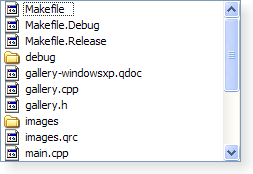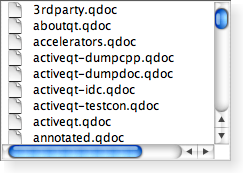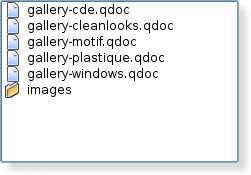QListWidget Class Reference |
 |  |  |
| A Windows XP style list widget. | A Macintosh style list widget. | A Plastique style list widget. |
See also QListWidgetItem, QListView, QTreeView, Model/View Programming, and Config Dialog Example.
Property Documentation
count : const int
This property holds the number of items in the list including any hidden items.
Access functions:
- int count () const
currentRow : int
This property holds the row of the current item.
Depending on the current selection mode, the row may also be selected.
Access functions:
- int currentRow () const
- void setCurrentRow ( int row )
sortingEnabled : bool
This property holds whether sorting is enabled.
If this property is true, sorting is enabled for the list; if the property is false, sorting is not enabled. The default value is false.
This property was introduced in Qt Qt 4.2.
Access functions:
- bool isSortingEnabled () const
- void setSortingEnabled ( bool enable )
Member Function Documentation
QListWidget::QListWidget ( QWidget * parent = 0 )
Constructs an empty QListWidget with the given parent.
QListWidget::~QListWidget ()
Destroys the list widget and all its items.
void QListWidget::addItem ( const QString & label )
Inserts an item with the text label at the end of the list widget.
void QListWidget::addItem ( QListWidgetItem * item )
This is an overloaded member function, provided for convenience.
Inserts the item at the the end of the list widget.
Warning: A QListWidgetItem can only be added to a QListWidget once. Adding the same QListWidgetItem multiple times to a QListWidget will result in undefined behavior.
See also insertItem().
void QListWidget::addItems ( const QStringList & labels )
Inserts items with the text labels at the end of the list widget.
See also insertItems().
void QListWidget::clear () [slot]
Removes all items and selections in the view.
void QListWidget::closePersistentEditor ( QListWidgetItem * item )
Closes the persistent editor for the given item.
See also openPersistentEditor().
QListWidgetItem * QListWidget::currentItem () const
Returns the current item.
See also setCurrentItem().
void QListWidget::currentItemChanged ( QListWidgetItem * current, QListWidgetItem * previous ) [signal]
This signal is emitted whenever the current item changes. The previous item is the item that previously had the focus, current is the new current item.
void QListWidget::currentRowChanged ( int currentRow ) [signal]
This signal is emitted whenever the current item changes. The currentRow is the row of the current item. If there is no current item, the currentRow is -1.
void QListWidget::currentTextChanged ( const QString & currentText ) [signal]
This signal is emitted whenever the current item changes. The currentText is the text data in the current item. If there is no current item, the currentText is invalid.
bool QListWidget::dropMimeData ( int index, const QMimeData * data, Qt::DropAction action ) [virtual protected]
Handles the data supplied by a drag and drop operation that ended with the given action in the given index. Returns true if the data and action can be handled by the model; otherwise returns false.
See also supportedDropActions().
void QListWidget::editItem ( QListWidgetItem * item )
Starts editing the item if it is editable.
QList<QListWidgetItem *> QListWidget::findItems ( const QString & text, Qt::MatchFlags flags ) const
Finds items with the text that matches the string text using the given flags.
QModelIndex QListWidget::indexFromItem ( QListWidgetItem * item ) const [protected]
Returns the QModelIndex assocated with the given item.
void QListWidget::insertItem ( int row, QListWidgetItem * item )
Inserts the item at the position in the list given by row.
See also addItem().
void QListWidget::insertItem ( int row, const QString & label )
This is an overloaded member function, provided for convenience.
Inserts an item with the text label in the list widget at the position given by row.
See also addItem().
void QListWidget::insertItems ( int row, const QStringList & labels )
Inserts items from the list of labels into the list, starting at the given row.
See also insertItem() and addItem().
QListWidgetItem * QListWidget::item ( int row ) const
Returns the item that occupies the given row in the list if one has been set; otherwise returns 0.
See also row().
void QListWidget::itemActivated ( QListWidgetItem * item ) [signal]
This signal is emitted when the item is activated. The item is activated when the user clicks or double clicks on it, depending on the system configuration. It is also activated when the user presses the activation key (on Windows and X11 this is the Return key, on Mac OS X it is Ctrl+0).
QListWidgetItem * QListWidget::itemAt ( const QPoint & p ) const
Returns a pointer to the item at the coordinates p.
QListWidgetItem * QListWidget::itemAt ( int x, int y ) const
This is an overloaded member function, provided for convenience.
Returns a pointer to the item at the coordinates (x, y).
void QListWidget::itemChanged ( QListWidgetItem * item ) [signal]
This signal is emitted whenever the data of item has changed.
void QListWidget::itemClicked ( QListWidgetItem * item ) [signal]
This signal is emitted with the specified item when a mouse button is clicked on an item in the widget.
See also itemPressed() and itemDoubleClicked().
void QListWidget::itemDoubleClicked ( QListWidgetItem * item ) [signal]
This signal is emitted with the specified item when a mouse button is double clicked on an item in the widget.
See also itemClicked() and itemPressed().
void QListWidget::itemEntered ( QListWidgetItem * item ) [signal]
This signal is emitted when the mouse cursor enters an item. The item is the item entered. This signal is only emitted when mouseTracking is turned on, or when a mouse button is pressed while moving into an item.
QListWidgetItem * QListWidget::itemFromIndex ( const QModelIndex & index ) const [protected]
Returns a pointer to the QListWidgetItem assocated with the given index.
void QListWidget::itemPressed ( QListWidgetItem * item ) [signal]
This signal is emitted with the specified item when a mouse button is pressed on an item in the widget.
See also itemClicked() and itemDoubleClicked().
void QListWidget::itemSelectionChanged () [signal]
This signal is emitted whenever the selection changes.
See also selectedItems(), isItemSelected(), and currentItemChanged().
QWidget * QListWidget::itemWidget ( QListWidgetItem * item ) const
Returns the widget displayed in the given item.
This function was introduced in Qt 4.1.
See also setItemWidget().
QList<QListWidgetItem *> QListWidget::items ( const QMimeData * data ) const [protected]
Returns a list of pointers to the items contained in the data object. If the object was not created by a QListWidget in the same process, the list is empty.
QMimeData * QListWidget::mimeData ( const QList<QListWidgetItem *> items ) const [virtual protected]
Returns an object that contains a serialized description of the specified items. The format used to describe the items is obtained from the mimeTypes() function.
If the list of items is empty, 0 is returned rather than a serialized empty list.
QStringList QListWidget::mimeTypes () const [virtual protected]
Returns a list of MIME types that can be used to describe a list of listwidget items.
See also mimeData().
void QListWidget::openPersistentEditor ( QListWidgetItem * item )
Opens an editor for the given item. The editor remains open after editing.
See also closePersistentEditor().
void QListWidget::removeItemWidget ( QListWidgetItem * item )
Removes the widget set on the given item.
This function was introduced in Qt 4.3.
int QListWidget::row ( const QListWidgetItem * item ) const
Returns the row containing the given item.
See also item().
void QListWidget::scrollToItem ( const QListWidgetItem * item, QAbstractItemView::ScrollHint hint = EnsureVisible ) [slot]
Scrolls the view if necessary to ensure that the item is visible. The hint parameter specifies more precisely where the item should be located after the operation.
QList<QListWidgetItem *> QListWidget::selectedItems () const
Returns a list of all selected items in the list widget.
void QListWidget::setCurrentItem ( QListWidgetItem * item )
Sets the current item to item.
Depending on the current selection mode, the item may also be selected.
See also currentItem().
void QListWidget::setItemWidget ( QListWidgetItem * item, QWidget * widget )
Sets the widget to be displayed in the give item.
This function should only be used to display static content in the place of a list widget item. If you want to display custom dynamic content or implement a custom editor widget, use QListView and subclass QItemDelegate instead.
This function was introduced in Qt 4.1.
See also itemWidget() and Delegate Classes.
void QListWidget::sortItems ( Qt::SortOrder order = Qt::AscendingOrder )
Sorts all the items in the list widget according to the specified order.
Qt::DropActions QListWidget::supportedDropActions () const [virtual protected]
Returns the drop actions supported by this view.
See also Qt::DropActions.
QListWidgetItem * QListWidget::takeItem ( int row )
Removes and returns the item from the given row in the list widget; otherwise returns 0.
Items removed from a list widget will not be managed by Qt, and will need to be deleted manually.
See also insertItem() and addItem().
QRect QListWidget::visualItemRect ( const QListWidgetItem * item ) const
Returns the rectangle on the viewport occupied by the item at item.
Best Of
Actualités les plus lues
- Quelles nouveautés de C++11 Visual C++ doit-il rapidement intégrer ? Donnez-nous votre avis 10
- « Quelque chose ne va vraiment pas avec les développeurs "modernes" », un développeur à "l'ancienne" critique la multiplication des bibliothèques 9
- Partage de données explicite et implicite avec Qt, un article de Christophe Dumez traduit par Thibaut Cuvelier 0
- Créer des applications avec un style Metro avec Qt, exemples en QML et C++, un article du blog Digia traduit par Thibaut Cuvelier 0
- Microsoft ouvre aux autres compilateurs C++ AMP, la spécification pour la conception d'applications parallèles C++ utilisant le GPU 22
- Les développeurs ignorent-ils trop les failles découvertes dans leur code ? Prenez-vous en compte les remarques des autres ? 17
- RIM : « 13 % des développeurs ont gagné plus de 100 000 $ sur l'AppWord », Qt et open-source au menu du BlackBerry DevCon Europe 0
- BlackBerry 10 : premières images du prochain OS de RIM qui devrait intégrer des widgets et des tuiles inspirées de Windows Phone 0
- Adieu qmake, bienvenue qbs : Qt Building Suite, un outil déclaratif et extensible pour la compilation de projets Qt 17
- Quelles nouveautés de C++11 Visual C++ doit-il rapidement intégrer ? Donnez-nous votre avis 10
- La rubrique Qt a besoin de vous ! 1

- Linus Torvalds : le "C++ est un langage horrible", en justifiant le choix du C pour le système de gestion de version Git 100
- Comment prendre en compte l'utilisateur dans vos applications ? Pour un développeur, « 90 % des utilisateurs sont des idiots » 229
- Quel est LE livre que tout développeur doit lire absolument ? Celui qui vous a le plus marqué et inspiré 96
- Apple cède et s'engage à payer des droits à Nokia, le conflit des brevets entre les deux firmes s'achève 158
- Nokia porte à nouveau plainte contre Apple pour violation de sept nouveaux brevets 158
- Quel est le code dont vous êtes le plus fier ? Pourquoi l'avez-vous écrit ? Et pourquoi vous a-t-il donné autant de satisfaction ? 83
- Le Draft final de la norme C++ 0X validé 181

Le Qt Quarterly au hasard

Des apparences personnalisées utilisant les feuilles de style
Communauté
Ressources
- 91 cours et tutoriels Qt
- F.A.Q. Qt : 200 questions et réponses
- 48 Qt Quarterly, 35 Qt Labs et 22 Qt DevNet en français
- 43 outils Qt
- 99 sources Qt
- 26 binaires Qt
- 6 livres Qt et 9 critiques
- La documentation de Qt 4.7 en français : 157 classes, 70 concepts et 24 modules
- 3 certifications Qt
Liens utiles
Contact
- Vous souhaitez rejoindre la rédaction ou proposer un tutoriel, une traduction, une question... ? Postez dans le forum Contribuez ou contactez-nous par MP ou par email (voir en bas de page).
Qt dans le magazine
| Cette page est une traduction d'une page de la documentation de Qt, écrite par Nokia Corporation and/or its subsidiary(-ies). Les éventuels problèmes résultant d'une mauvaise traduction ne sont pas imputables à Nokia. | Qt 4.3 | |
| Copyright © 2012 Developpez LLC. Tous droits réservés Developpez LLC. Aucune reproduction, même partielle, ne peut être faite de ce site et de l'ensemble de son contenu : textes, documents et images sans l'autorisation expresse de Developpez LLC. Sinon, vous encourez selon la loi jusqu'à 3 ans de prison et jusqu'à 300 000 E de dommages et intérêts. Cette page est déposée à la SACD. | ||
| Vous avez déniché une erreur ? Un bug ? Une redirection cassée ? Ou tout autre problème, quel qu'il soit ? Ou bien vous désirez participer à ce projet de traduction ? N'hésitez pas à nous contacter ou par MP ! | ||
Copyright © 2000-2012 - www.developpez.com



















